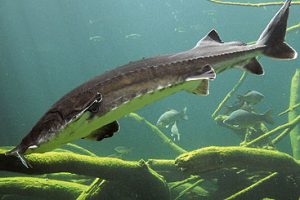Danube Sturgeon:

According to a report released by the World Wildlife Fund (WWF), the illegal sale of Danube Sturgeon, one of the most endangered species in the world, is rampant in the lower Danube (River) region, especially in Bulgaria, Romania, Serbia, and Ukraine.
- The Danube is the second-longest river in Europe after the Volga. It rises in the Black Forest mountains of western Germany and flows for some 2,850 km to its mouth on the Black Sea.
- Sturgeons have existed since the time of dinosaurs, for about 200 million years. Some of the species can grow up to eight metre in length and live more than a century.
- They are called ‘living fossils’ because their appearance has altered very little over the years.
- Living Fossil is an organism that has remained unchanged from earlier geologic times and whose close relatives are usually extinct.
- Other than Sturgeons, Horseshoe crab and ginkgo trees are examples of living fossils.
- Because the sturgeons live for so many years, mature late and spawn with long intervals, they take a long time to recover from environmental and human pressures, according to WWF. This makes them great indicators for the health of the river and other ecological parameters.
- There are 27 species of sturgeons and paddlefishes distributed across the Northern hemisphere. While some species inhabit only freshwater, most species are anadromous, spawning in freshwater but spending much of their life history in marine or brackish environments.
- Danube sturgeons live mostly in the Black Sea, migrating up the Danube and other major rivers to spawn.
Threats:
- Over-exploitation and poaching (exacerbated by poor fishery management and insufficient legal enforcement of fishing bans).
- Blocked migration routes through dams.
- Loss or degradation of habitats.
- Pollution.
Protection Status:
- IUCN Red list: There are 6 species of sturgeon in the Danube River. Five of them are now listed as critically endangered.
- CITES: Appendix-II.
About World Wildlife Fund for Nature:
- It is the world’s leading conservation organization and works in more than 100 countries.
- It was established in 1961 and is headquartered in Gland, Switzerland.
- Mission: To conserve nature and reduce the most pressing threats to the diversity of life on Earth




